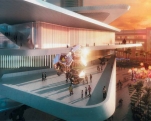LAAM: Fine Arts in Sculptural Gardens

With occasion of Art Basel Miami Beach 2014, FR-EE / Fernando Romero EnterprisE has announced the design of the new Latin American Art Museum (LAAM), in Miami. For the last 15 years, Miami has experienced a boom, evident in the architectonic explosion and other initiatives, such as Art Basel Miami, which has seduced the international audience since 2002. In 2014 the fair was attended by over 75 thousand people.
Today, Miami is some sort of lab in which global tendencies converge with local characteristics. Miami’s peculiar rise translates in a high life quality. The public services have been a temptation for people who are thinking about relocating or establishing a second place, as well as a standard destination for international tourists. Last November President Barack Obama allowed millions of illegal immigrants (most of them Latinos or Hispanics) to establish legally in the USA. In this historical sociopolitical context, the proposal for a new museum for Latin American art is a trigger to renovate the relations with the USA, and it also constitutes an unbeatable chance to rethink the significance of Latin American architecture and art in America.
Project
A private art collector, who specializes in modern and contemporary art from Latin America, is developing his well-known gallery into a new museum: the Latin American Art Miami (LAAM). The collection includes artists such as Diego Rivera, Fernando Botero, Wifredo Lam, Guillermo Kutica, Roberto Matta, Rufino Tamayo, among others. He invited FR-EE to design the first home for the museum.
The building is inspired by the different sections of the urban composite of Miami, whose outline gives shape to each of the four levels. LAAM is going to be situated within a residential complex, so it will work as the main access to the people living in the 111 apartments, which are going to be built later. The idea behind this conception is to offer something we could call “aesthetical quality life”. Thus, the museum going to be a sort of meeting point for the residents and their visits.
In order to translate this context, Fernando Romero has proposed a building generous in terraces and open spaces to transfer the exterior context into the building. The terraces of the different floors can indeed be called “sculptural gardens”, since they will contain the art pieces at open air. This will emphasize the benefits of the tropical architecture, such as natural air circulation, access to open spaces, foliage and the presence of the sea and the sun. The terraces will also spark off the curiosity of the neighbors and the pedestrians strolling in Biscayne Boulevard, so it will also work as an invitation to visit the museum.
Full content of this issue you can read here
The full version of the article can be read in our printed issue, also you can subscribe to the web-version of the magazine
 Materials provided by FR -EE / Fernando Romero EnterprisE
Materials provided by FR -EE / Fernando Romero EnterprisE


